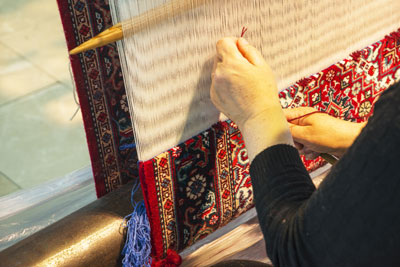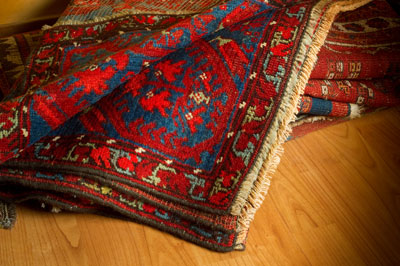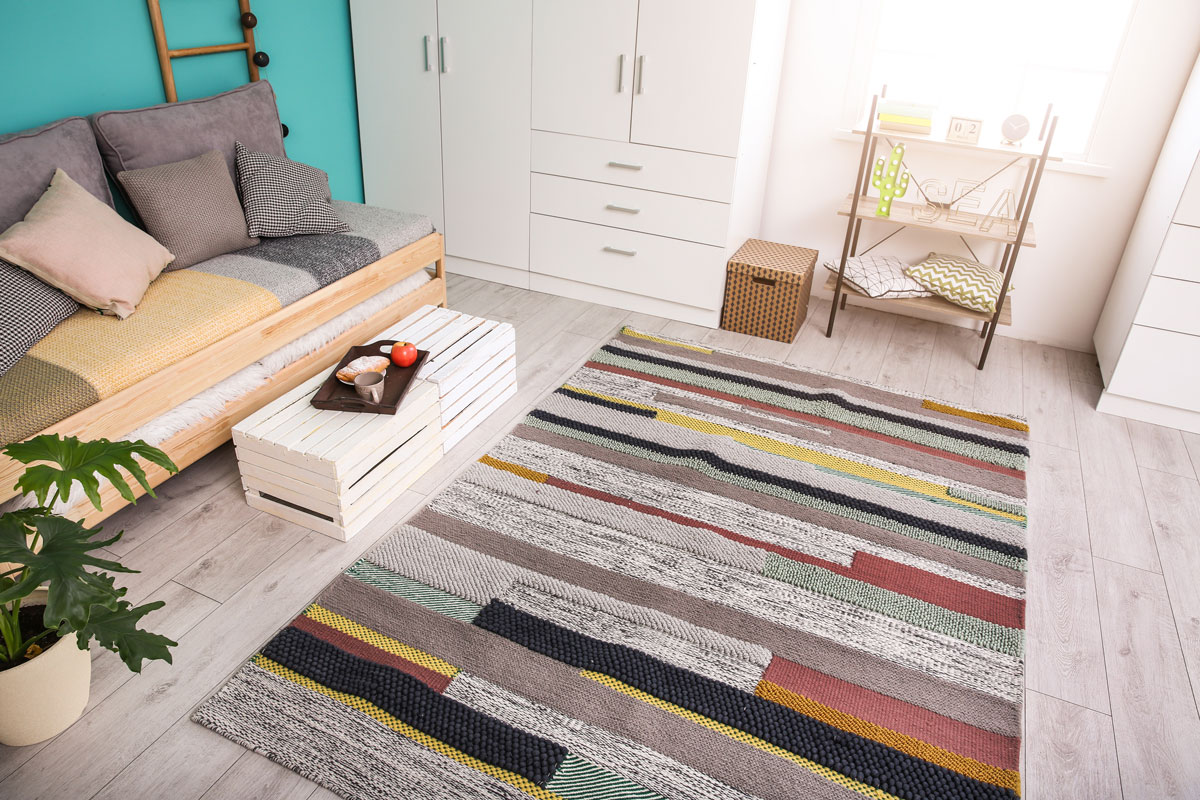If you’re looking to save money on your home decor, you’ve probably considered buying a machine-made rug. These mass-produced rugs are typically far cheaper than their hand-knotted counterparts, and the designs can be just as beautiful.
However, there are enormous differences in the manufacturing process and quality of machine-made rugs.
Many people swear that machine-made rugs can never compare to a hand-knotted heirloom. Both hand-made and machine-made rugs can last for decades when properly cared for, but hand-knotted rugs are more likely to last through the generations.
Here’s everything you need to know before buying a machine-made rug.
The Differences Between Machine-Made and Hand-Made
 Traditional hand-knotted rugs can take extremely long to make. The weaver must insert fibers into the foundation of the rug and tie them by hand, an extremely tedious and time-consuming process. This level of effort is part of why many hand-knotted rugs are often worth thousands of dollars and passed down as collectibles.
Traditional hand-knotted rugs can take extremely long to make. The weaver must insert fibers into the foundation of the rug and tie them by hand, an extremely tedious and time-consuming process. This level of effort is part of why many hand-knotted rugs are often worth thousands of dollars and passed down as collectibles.
With machine methods, it’s possible to produce rugs in a matter of hours. Power looms can be programmed to efficiently perform all the tedious labor that someone would otherwise have to do by hand. With all the time and labor savings, it’s possible to produce machine-made lugs at a far lower price point.
For all the differences in manufacturing, it can sometimes be hard to tell whether a rug is machine- or hand-made. One of the best ways is to turn the rug over on its back.
If the weaving and knotting look perfectly even, it’s probably machine-made. Irregularities suggest that the rug was made by hand, although machines today can imitate the imperfections of hand-made rugs.
Fringes can also give away a machine-made rug. For hand-made rugs, fringes are an integral part of the rug created using the ends of the fibers in the pile. If the fringe is stitched or sewn onto the side of the rug, it’s almost certainly machine-made.
The Manufacturing Process
Machine-made rugs are produced using power looms. These huge machines have the ability to create many rugs with the same length, pattern, and/or design at a much faster pace than human hands. By cutting down time and labor costs, companies can quickly distribute and sell these rugs at a much lower price point.
A power loom works by wrapping individual fibers around foundation threads and pressing them together. It’s a similar process to making a hand-made rug, but much faster and done with electronics.
Power looms are automated and controlled by computers. This allows manufacturers to create a far more uniform surface than is achievable by hand. However, some manufacturers are now programming machines to make mistakes so the final product appears more like a hand-made rug.
Materials Used in Machine Made Rugs
Certain materials are more prevalent in machine-made rugs than in hand-made rugs.
The most common materials used to make machine-made rugs are lightweight synthetic materials. Polypropylene, nylon, acrylic, and art silk are all popular choices. Natural materials like wool and silk are far more common in hand-made rugs. However, they can still be used for machine-made rugs.
Valuing Machine-Made Rugs
 While many consumers love machine-made rugs, there’s no denying that they have less value than a hand-made rug.
While many consumers love machine-made rugs, there’s no denying that they have less value than a hand-made rug.
Machine-made rugs lack the uniqueness of a one-of-a-kind handmade rug. Since they’re far from one-of-a-kind and tend to deteriorate after a couple of decades, they’re not considered an investment in the same way that an Oriental rug might be.
That’s not to say no one values machine-made rugs. Certain brands such as Karastan are known for their exceptionally high quality and have a loyal following.
One of the best ways to tell whether a machine-made rug is low quality is to rub it between your fibers. Lint, fuzzballs, and other shedding could be a sign that the fiber is breaking down. Keep in mind that if your fingers can get a lot of lint out of your rug, your feet will loosen far more as you step across the rug from day to day.
Most machine-made rugs have a lifespan of 20 years or less, depending on the fibers. However, the highest quality machine-made rugs can last for decades if they are well-maintained. Keep in mind that the main factor determining how long your rug lasts, whether it’s machine-made or hand-knotted, it how well you care for it.
Caring for Your Rug
Machine-made rugs can be a fantastic option for consumers who have a lower budget or need an area rug in a high-traffic area. Kitchens, entryways, and garages deserve the beauty of an area rug, but you may not want to expose an expensive hand-made rug to all that dirt. Machine-made rugs are also a great option for those with children and pets who may cause more messes.
Regardless of the type of rug you have, it’s important to invest in its care. Proper rug cleaning and maintenance can lengthen the life of your rug by decades.
The type of care required depends on the rug material. Some rugs, including small cotton rugs, can go in the washing machine, while others should only be cleaned by a dedicated professional.
Alexander’s Rug Care provides all the rug care services you need in the Puget Sound area. We can remove stains, reweave damaged areas, and protect your rug from future injury. We are proudly committed to best practices.





